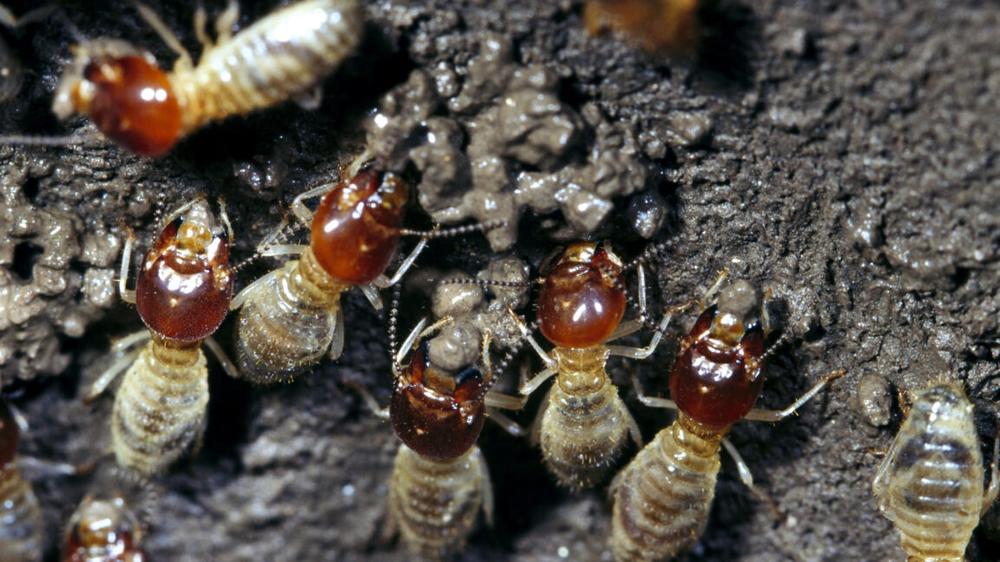Odontotermes obesus is one of the termite species that grows fungi, called Termitomyces, in their mounds. Workers collect dead leaves, wood, and grass to stack them in underground fungus gardens called combs. There, the fungi break down the tough plant fibers, making them accessible for the termites in an elaborate form of symbiotic agriculture.
Like any other agriculturalist, however, the termites face a challenge: weeds. “There have been numerous studies suggesting the termites must have some kind of fixed response—that they always do the same exact thing when they detect weed infestation,” says Rhitoban Raychoudhury, a professor of biological sciences at the Indian Institute of Science Education, “but that was not the case.” In a new Science study, Raychoudhury’s team discovered that termites have pretty advanced, surprisingly human-like gardening practices.
Going blind
Termites do not look like particularly good gardeners at first glance. They are effectively blind, which is not that surprising considering they spend most of their life in complete darkness working in endless corridors of their mounds. But termites make up for their lack of sight with other senses. "They can detect the environment based on advanced olfactory reception and touch, and I think this is what they use to identify the weeds in their gardens," Raychoudhury says. To learn how termites react once they detect a weed infestation, his team collected some Odontotermes obesus and challenged them with different gardening problems.
The experimental setup was quite simple. The team placed some autoclaved soil sourced from termite mounds into glass Petri dishes. On this soil, Raychoudhury and his colleagues placed two fungus combs in each dish. The first piece acted as a control and was a fresh, uninfected comb with Termitomyces. "Besides acting as a control, it was also there to make sure the termites have the food because it is very hard for them to survive outside their mounds," Raychoudhury explains. The second piece was intentionally contaminated with Pseudoxylaria, a filamentous fungal weed that often takes over Termitomyces habitats in termite colonies.
The team added the termites to the dishes along with a bit of water to make sure the environment was hospitable. Finally, the dishes were covered up and placed in total darkness in an incubator that maintained a temperature that accurately emulated the conditions in a termite mound.
"We observed what was going on in those dishes at regular time intervals and each time we took a peek, we took a photo," Raychoudhury says.
The resulting timelapses gave us the first glimpse at the way termites handled weed infestation in their fungal gardens. Their actions were completely different from the simple, fixed behaviors scientists expected to see.
Measured response
The first experiment was designed to simulate the very onset of Pseudoxylaria infestation in the colony. After the team placed a small piece of the weed on one of the combs in each dish, the termites had a wide range of tactics to deal with these early-stage infections. The most frequently used strategy saw the termites take three steps: "First, they removed the weed—took it away from the comb," Raychoudhury says. After the weed was removed, the termites buried it in the soil away from the combs. In the next step, they scraped off some of the comb where the weed had been located. This allowed the termites to contain the infection in 94 percent of samples.
"Then we said, ok, they can deal with early-stage infections—what about the scenarios where the infection gets through the initial stage and gets more severe?" Raychoudhury asked.
To bump the difficulty level up, the team performed another experiment where the termites had two pieces of comb again, only this time one of them was fresh and the other one contained mostly weeds. "We learned that termites did not try to retrieve [the] severely infected combs; they probably could determine these were beyond saving," Raychoudhury claims. To deal with these heavily infected combs, termites, simply covered them with soil.
The third experiment was aimed at learning how termites find the balance between how much of the infected comb they need to bury and how much they try to save. "By burying these combs, they are getting less and less space to grow their crops,” Raychoudhury says. “And termite colonies have millions of termites, and they all need to eat.” To trigger this kind of decision-making in termites, his team glued an infected piece of comb to a fresh piece of comb. The termites separated these combs along the joint where they were glued together and, as usual, covered the infected part with soil.
While most behaviors varied depending on the severity of the infection, covering the weed with soil was something termites did in almost every case. So, the team took a closer look at the dirt to figure out why it was so important in the process. It turned out the termites basically used it as a pesticide, but with a benevolent twist.
Benevolent agriculture
In the earlier research, Raychoudhury’s team learned that the microbes found in termite colonies were fungistatic—they inhibited the growth of fungi. It wasn’t clear why such microbes were there, since the termites’ very existence relies on growing fungi.
"The reason we provided termites with autoclaved soil in the first place was to rule out those fungistatic microbes came from the soil," Raychoudhury explains. It turned out the source of the microbes were the termites themselves, which form the soil into individual chunks the researchers call a bolus. "When they are making these boluses, they are secreting something out and whatever they are secreting comes from their gut," Raychoudhury explains. His team discovered that termites do not use those boluses indiscriminately but only apply them on the infested parts of their gardens. Unlike human pesticides, though, termite boluses were not lethal to the weed.
When Raychoudhury’s team recovered the weed termites buried with their fungistatic boluses, it was still able to grow. The result was to prevent the weed from spreading and doing harm to their crop, never to destroy it completely. "We don’t know exactly why they don’t kill it, but we have a hypothesis,” Raychoudhury claims. “I guess having a capacity to kill fungi when you grow fungi as food is just not a good strategy."
What scientists still need to find out is whether all the microbes the termites have in their gut are necessary for weed control, or whether there are just a few that play a major role in this process.
Termites live in a very confined environment with ideal growth conditions for various microbes. On top of that, the colonies have extremely low genetic variability since all the termites descend from the same queen and king. "These are perfect breeding grounds for many microbial pathogens," Raychoudhury explains. Finding out how termites deal with these pathogens is what his team wants to learn next. "How do they rid of these pathogens? In our experiments we only used the weed. Now we would like to use other pathogens and see how termites handle them," Raychoudhury says.
Science, 2025. DOI: 10.1126/science.adr2713

 You can still snag LG’s C4 OLED TV at half the price
You can still snag LG’s C4 OLED TV at half the price